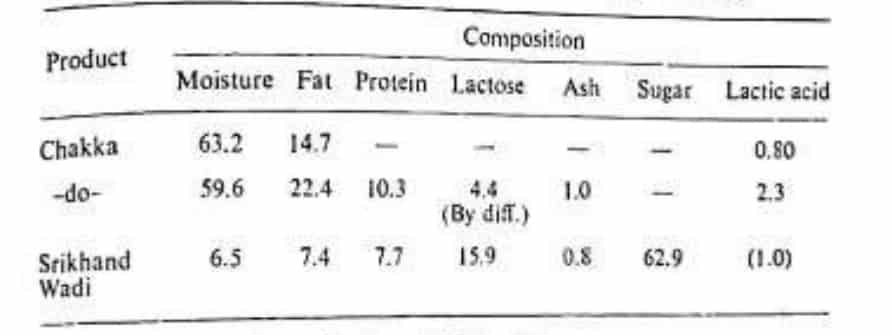Shrikhand Preparation
Shrikhand is a popular dessert from the Indian subcontinent, particularly in the states of Gujarat and Maharashtra. It is a sweet dish made from strained dahi or yogurt (also known as hung curd), sugar, and various flavorings such as cardamom, saffron, and nuts. Shrikhand is a semi-soft, sweetish-sour, whole milk product prepared from lactic fermented curd. To make Shrikhand, dahi or yogurt is first strained through a cheesecloth or muslin to remove the whey, resulting in a thick, creamy consistency. The strained dahi which is called Chakka is then mixed with sugar and flavorings, and sometimes also with fruit puree, such as mango or strawberry.
Shrikhand is typically served chilled as a dessert or a side dish with meals. It is often enjoyed during festivals and special occasions, and is considered a healthy alternative to other sugary desserts due to its high protein content.

Composition of Chakka
The composition of chakka will depend the –
- Initial composition of milk
- The degree of fermentation and
- The extent of whey removed.
These three factors, together with the amount of sugar added, influence the composition of shrikhand. The composition of Shrikhand wadi depends upon the extent to which Shrikhand is desiccated. The average composition of chakka (samples made from buffalo milk in lab), Shrikhand wadi are given in below table.
Composion of Chakka and Shrikhand wadi* (percentage)
[Reference: Outlines of Dairy Technology by Prof. S. Dey]

Standardized Method of Shrikhand preparation
The standardized method (as per book Outlines of Dairy Technology by Prof. S. Dey) of preparation may be described as follows: fresh, sweet buffalo milk, which has been standardized to 6% fat, is pasteurized at 71°C for 10 minutes and then cooled to 28-30°C. It is then inoculated @1.0 percent with lactic culture (Streptococcus lactis), which is mixed well, and incubated at 28-30°C for 15-16 hours (overnight). When the curd has set firmly (acidity 0.7-0.8 per cent lactic), it is broken and placed in a muslin cloth bag and hung on a peg for the removal of whey for 8-10 hours. During this period, the position of the curd may be altered, or the curd gently squeezed, to facilitate whey drainage. The solid mass thus obtained is called chakka, which is the Shrikhand base. This chakka is then admixed with sugar (crystal or ground) and well kneaded for uniform mixing; colour and flavour may also be added. The product now obtained is known as Shrikhand. When the Shrikhand is further desiccated to a hard mass by heating on an open pan over a direct fire, Shrikhand wadi is obtained.
Uses of Chakka
- Chakka is used for the preparation of Shrikhand.
- Shrikhand is used either for direct consumption or for the pre-paration of the Shrikhand wadi sweet.
- Shrikhand wadi is used for direct consumption.
Common recipe for making Shrikhand at home
Ingredients
4 cups of plain full fat dahi
1 cup of powdered sugar
1/2 teaspoon of cardamom powder
A pinch of saffron strands
3-4 tablespoons of chopped almonds and pistachios
Instructions for Shrikhand Preparation
Place the dahi or yogurt in a muslin cloth or cheesecloth and tie it tightly.
Hang the cloth with the dahi over a bowl or sink to allow the whey to drain out for several hours or overnight, until the yogurt becomes thick and creamy.
In a mixing bowl, combine the strained dahi, powdered sugar, cardamom powder, and saffron strands. Mix well until smooth and creamy.
Garnish the Shrikhand with chopped nuts before serving.
Note: You can also add fruit puree, such as mango or strawberry, to the Shrikhand for added flavor and texture


